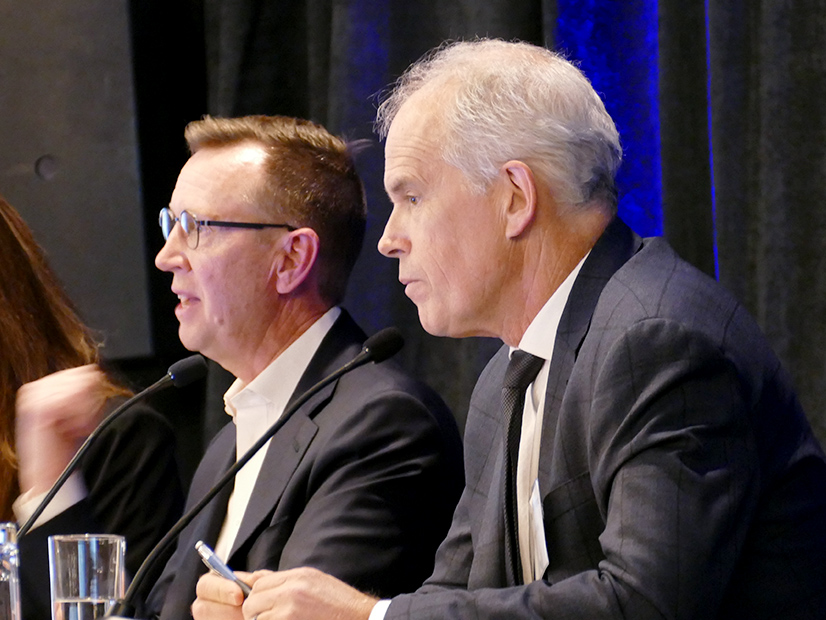Stakeholders Endorse Manual Revisions for Real-time Values
VALLEY FORGE, Pa. — The PJM Market Implementation Committee overwhelmingly voted to endorse manual revisions to put limits on when generators can submit real-time values.
The revisions would only permit real-time values to be used for physical unit limitations or circumstances outside the generation owner’s control. Documentation of those factors would be required to be submitted to PJM and the Independent Market Monitor within three days. If real-time values are improperly submitted, PJM’s Lauren Strella Wahba said the RTO would have the ability to reject them after the fact and the option to refer the seller to FERC.
Real-time values are meant to be a temporary way for generators to provide PJM its operating capabilities when it cannot satisfy its unit-specific parameter limits or approved parameter-limited exceptions. The RTO has found that the values have been used to override parameter limits or exceptions in some instances, Wahba told the MIC, while in other circumstances dispatchers would only become aware of a deviation from operating parameters when they called upon a unit.
FERC rejected a previous proposal to codify real-time values in the tariff, stating in a May 2021 order that submissions would not have been based on actual physical or operational constraints. The commission also stated that PJM’s status quo governing documents could contain market power issues (EL21-78).
Several stakeholders questioned why PJM sought endorsement of new manual language rather than embarking directly on making tariff revisions. PJM’s Chen Lu said real-time values currently exist in the manuals without a requirement for physical constraints and by making manual revisions now, the changes can be implemented while stakeholders work toward a FERC filing on tariff revisions.
Quick Fix Proposed to Address Falling Synch Reserve Deployment Response Rate
PJM proposed initiating a quick-fix process to address synchronized reserve deployment times exceeding PJM’s 10-minute internal standard since it implemented an overhaul of the reserve market on Oct. 1, 2022. Nonperformance rates have also increased to around 49% during the eight reserve deployments since the implementation, excluding those during the December 2022 winter storm.
The quick-fix process allows for a problem statement and issue charge to be endorsed concurrently with a proposed solution. Under the proposed manual revisions, PJM would be able to extend the second step of the operating reserve demand curve (ORDC) process by taking nonperforming reserve resources into account, allow the addition of on- and off-peak periods, and require that the extended values be posted as they’re changed.
PJM’s Phil D’Antonio said the RTO believes that the issue lies in market participant training, rather than in the pricing of reserves, and ongoing outreach to generators will yield progress. Glen Boyle, also of PJM, said that because penalties are based on synchronized reserve revenues earned and clearing prices are low, penalties are also low at this time.
Monitor Joe Bowring said he believes the issue is not appropriate for a quick-fix solution, as there is no demonstrated reliability issue that would be addressed by the proposed change.
He noted that PJM’s proposal would nearly quintuple the second step of the ORDC, from 190 MW to 890 MW, without any quantitative support for that significant a change, which he argued would trigger shortage prices more often and increase the price of synchronized reserves. Bowring also pointed out that the Oct. 1, 2022, change in the reserve market design increased the supply of synchronized reserves and included a must-offer requirement. He argued reserve prices since Oct. 1 have not been too low but have appropriately reflected the balance of supply and demand.
Under the applicable NERC standards, only one spinning event has exceeded the limit, and that is under investigation, Bowring said. He agreed with PJM that individual unit response times have been a problem and that both the Monitor and PJM are contacting individual unit owners to investigate the reasons for the poor performance. Bowring also stated that PJM’s rules for not paying resource owners for nonperformance were too weak and contributed to the performance issues.
Stakeholders Fine-tune Design Components on Local Considerations for Net CONE
Stakeholders continued the identification of design components to include in the drafting of proposals on whether and how to include regional factors impacting the net cost of new entry (CONE), such as environmental regulations or taxes. The MIC also discussed interests and design components during the February and March meetings, with the next phase being the creation of packages. (See “Discussion on Local Considerations for Net CONE,” PJM MIC Briefs: March 8, 2023.)
James Wilson, a consultant for five state consumer advocates, recommended two design components: a transition mechanism when net CONE is updated, potentially capping any increase at 20% during years between Quadrennial Reviews; and consideration of changes to the variable resource requirement (VRR) capacity demand curve shape — the latter of which he acknowledged had previously been ruled out of scope, which he suggested could ultimately result in any proposal to just change net CONE rules being rejected by FERC.
Stakeholders discussed whether CONE values and the reference resource should be reviewed whenever an impact, particularly signed legislation, is identified, including in between Quadrennial Reviews.
The discussion also looked at whether the creation of a new CONE area should result in the original region parameters being recalculated to account for the different footprint, particularly if the reference resource was based in the excised area.
Discussion on Co-located Load Packages
Several proposals to define how configurations in which load is directly connected to generators fit into PJM’s rules continued to be discussed by stakeholders.
Much of the discussion was centered on whether generators co-located with load that does not have a direct interconnection to the transmission grid should be required to relinquish a portion of their capacity interconnection rights (CIRs) equal to the energy consumed by the load, as they currently are, or if they should be permitted to retain that capacity, as well as whether interconnection and ancillary services charges should be assessed. (See “Proposals on Rules for Generation with Co-located Load Presented,” PJM MIC Briefs: March 8, 2023.)
Exelon’s Sharon Midgley said the company’s proposal would allow generators to retain their CIRs, but the facility would be classified as a load-serving entity for the co-located load and all applicable LSE charges and credits would be applied to it. She noted the package currently only focuses on capacity resources, but it will be expanded in the future to consider energy-only generation, given the interest expressed by other PJM members as well.
“Our primary interest is having more clarity in PJM’s rules,” she said.
A proposal from the Advanced Energy Management Alliance would codify all status quo rules and practices, with the addition of creating penalties for the host generator if the co-located load is not curtailed when the generator is dispatched.
Two proposals from the Monitor and a joint package from Constellation Energy and Brookfield Renewable remain largely unchanged since the MIC showed less than 20% support in a November poll. Following the poll, Bowring — whose package largely codifies existing practices and adds administrative requirements and charges — suggested discontinuing the discussion, but stakeholders felt that clarified rules are needed.
The Constellation-Brookfield proposal would allow generators to retain their full CIRs without making either the generation or the load subject to ancillary service charges, under the argument that the load does not benefit from grid services. Former Constellation Director of Wholesale Market Development Jason Barker stated that the arrangement the company envisioned under the rules would be a nuclear facility supplying power for highly interruptible load, such as hydrogen electrolyzers. (See “Limited Support for Co-located Load Proposals,” PJM MIC Briefs: Dec. 7, 2022.)
Bowring argued that PJM should be required to assess the impact of diverting a significant amount of low-cost energy off the grid to meet new load added to the grid behind the generators. He also said that emissions would increase as a result because nuclear energy would be dedicated to the new loads while existing load would be met by the emitting resources at the top of the supply stack. A related result would be an increase in energy market prices that the Monitor had previously estimated as exceeding a billion dollars, Bowring said.
“Nuclear plants were never built to provide energy for a few hours per year. The promise to provide energy from the resources for a few peak hours a year is not consistent with the obligation of capacity resources.”
First Read on Smooth Supply Curve Quick Fix
PJM presented a proposal to initiate a quick fix process to clarify that the informational smoothed supply curves PJM publishes after Base Residual Auctions will not be created for Incremental Auctions (IAs). PJM’s Skyler Marzewski told the committee that PJM cannot create smoothed supply curves for IAs because of the lack of demand curves in those auctions and the risk that they could be used to expose market sensitive data.



